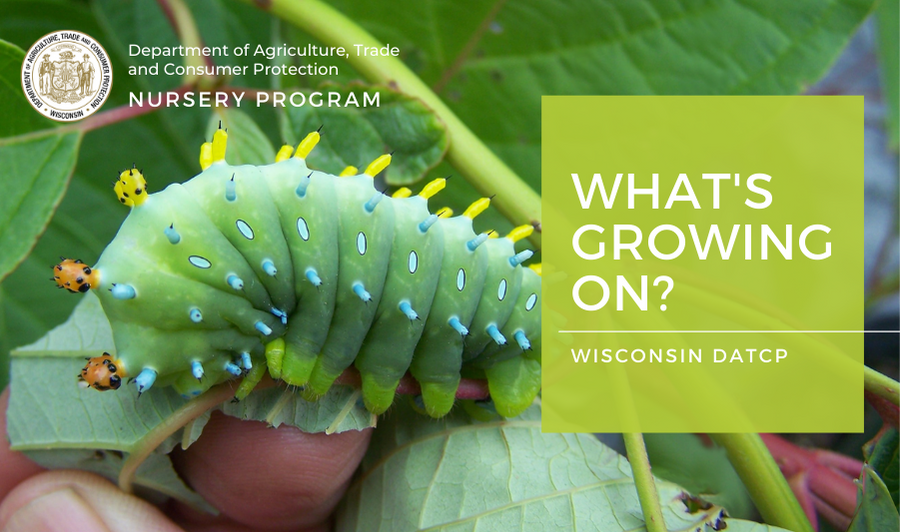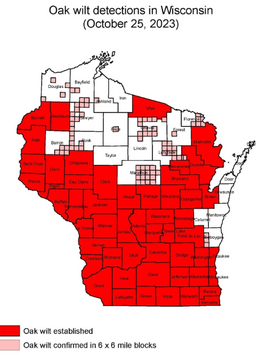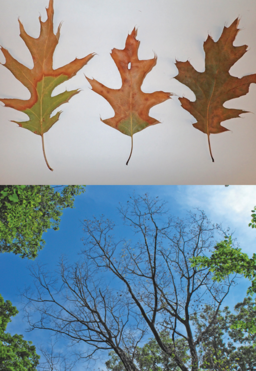|
 _____________________________________
Dear Wisconsin nurseries, Christmas tree growers, and gardeners:
As of March 13, 2024, accumulated growing degree days across Wisconsin range from 104 GDDs at Sinsinawa/Dubuque (the warmest location) to 18 GDDs at Bayfield (the coldest location). Madison has so far accumulated 78 GDDs. (Note these are using the modified base 50°F calculation method with min temp of 50°F and max temp of 86°F. The modified base 50 is more accurate for forecasting pest development early in the season when night temps are still low (>50F). Normally for this newsletter, GDDs are reported using the simple base 50 calculation.) GDD (mod50) totals in a few other parts of the state are at 44 in Medford, 41 in Wausau, 69 in Hancock, 54 in Green Bay, 79 in Racine, and 82 in La Crosse.
In 2023, Sinsinawa/Dubuque didn’t accumulate 104 GDDs until April 12, Bayfield hit 18 GDDs on April 11, and Madison didn’t reach 78 GDDs until April 12. Compared to the 30-year normals (1991-2020), Dubuque/Sinsinawa would typically accumulate 75 GDDs around April 13 and Madison would normally reach 78 GDDs around April 9.
In short, Wisconsin GDD accumulations are currently a whopping 28-29 calendar days ahead of 2023 and about 26-30 calendar days ahead of the 30-year normals! This should make for an interesting and early start to the 2024 season! Of course when making planting decisions, you should also consider average last spring freeze dates for your area.
Please send any feedback, questions, or ideas for future e-news updates to datcpnursery@wisconsin.gov.
Having trouble viewing this email? View it as a Web page.
_____________________________________
|
|
|
Growing Degree Days (GDD) are a measurement of the growth and development of plants and insects during the growing season. We use simple base 50 GDDs in this newsletter since most pests and diseases are not actively developing below 50 degrees Fahrenheit. Simple GDDs can be calculated by adding the high and low temperatures of the day, then divide by 2. From this number minus 50. This gives you the simple GDD base 50 (B50). Total daily GDD to get the current degree days.
(High + Low) / 2 – 50 = GDD
For many pests and diseases, vulnerable life stages in their life cycle correspond to known GDD values. By knowing the time of an insect's or diseases' most vulnerable stage, control measures can be timed for when they are likely to be most effective.
Knowing GDDs is extremely helpful for good insect pest management. However, scouting is also key as there are always variables like available moisture, nutrients, and shade or sunlight that may influence insect and disease growth rates by a few GDDs, give or take.
Read more on GDDs and synchronous phenological indicators (SPI) in the April 2023 issue of What's Growing On?. Check out other climate trackers on the Midwestern Regional Climate Center website.
_____________________________________
|
|
|
Aconitum with Cucumber mosaic virus | DATCP image
This is part 1 of a brief series on virus transmission methods to consider when working with plants.
There are many ways that viruses can spread between plants. One of these is through vectors; organisms that transmit pathogens from one plant to another, spreading infection. Insects, mites, and nematodes can all be vectors for plant viruses.
Common vector insects include aphids, leafhoppers, planthoppers, thrips, and whiteflies. The insect acquires the virus by feeding on an infected plant. When the insect feeds on a new, healthy plant, it may infect the new plant with the virus. The virus may also be spread to any offspring produced by the vector.
There are many viruses that can be spread by insect vectors. Some common examples include potato virus Y and cucumber mosaic virus, which are vectored by aphids; and impatiens necrotic spot virus and tomato spotted wilt virus, which are vectored by Western flower thrips.
To prevent the spread of viruses via insect vectors, monitor and control insect vector populations. Manage weeds in the growing area, as these can act as reservoirs of plant viruses. Dispose of plants symptomatic for virus to prevent spread to other plants. There are no treatment options for virus-infected plants.
_____________________________________
|
|
|
A new resources for pest risk assessment | SAFARIS website
SAFARIS (Spatial Analytic Framework for Advanced Risk Information Systems) is a new resource for anyone in plant production or management looking to more effectively anticipate and monitor for invasive plant pests based on local data.
SAFARIS has four main data components on which it runs: biotic and abiotic data drivers, pest information and expert opinions, forecast models and analytic tools, and pest forecast archival materials. The phenology prediction models, spread forecasting models, and other climate-based analytical tools in SAFARIS help users understand which geographic regions are suitable for establishment and when scouting or surveys would be most effective.
"PestCAST" is one of the SAFARIS tools that uses near real-time weather data, seven-day forecast, and historical weather data to forecast pest stages at the current date, for the next seven days, and for the next 30 days. It's currently available for Asian longhorned beetle, box tree moth, European cherry fruit fly, Japanese beetle, old world bollworm, spongy moth, and spotted lanternfly.
Take a moment to check out this helpful website to help plan your scouting calendar for this year.
_____________________________________
|
|
|
Oak wilt is a fungal infection lethal to oaks caused by the pathogen Bretziella fagacearum. The fungus grows through the infected tree’s water conduction system, eventually causing the tree to wilt and die. This disease was first found in Wisconsin in 1944 and is thought to be invasive, but the origin of the pathogen is unknown. Although oak wilt has been in Wisconsin for quite some time now, there are parts of the state that have not been impacted. Management for this disease can be tricky and costly, so prevention is key.
|
|
 Oak wilt detections in Wisconsin | WI-DNR map
|
 Leaf discoloration (top) and leaf drop from upper canopy (bottom) of oak-wilt-infected tree | WI-DNR image
|
|
|
Red oaks are particularly susceptible, so species such as northern red, northern pin, and black oak are most at risk for death. The white oak group has shown much slower disease progression than those in the red oak group and may even survive the infection. However, any infected tree left standing is a continued vector for the disease to spread. Bark beetles can spread oak wilt overland by carrying fungal spores from infected trees to new trees as they feed on sap from fresh wounds. This disease can also spread short distances via root grafts underground between nearby trees. Symptoms can progress quickly within a few weeks and may be most noticeable in July and August.
What to look for:
- Dull green and bronze-colored leaves that appear wilted.
- Leaf discoloration and dieback starting in the crown of the tree.
- Sudden leaf drop also starting in the upper canopy.
The Wisconsin Department of Natural Resources recommends not wounding oaks from April-July each year in Wisconsin, based on the vector bark beetle activity. If you absolutely have to or otherwise accidentally wound your oaks, immediately apply pruning sealer over the wound. It is the open, fresh tree wound that attracts bark beetles and allows introduction of the fungal pathogen.
To learn more about oak wilt, check out the U.S. Forest Service’s new story map, titled "Oak Wilt in the Northeastern and Midwestern States." This resource provides a detailed overview of the disease and can help determine the most appropriate tools for prevention and treatment: Oak Wilt in the Northeastern and Midwestern States (arcgis.com). You can also visit Oak Wilt | | Wisconsin DNR for more Wisconsin-specific information and resources.
If you think your nursery stock may have oak wilt, contact your local inspector.
|
|
_____________________________________ |
|
|
2023 USDA Plant Hardiness Zone Map for Wisconsin | USDA ARS map
Have your checked your plant cold hardiness zone rating lately? The USDA Hardiness Zone Map - 2023 was revised in late 2023 using weather station data collected over 30 years (1991-2020). The data collected averaged the lowest temperatures - not the lowest temperature ever. The hardiness zone map before this was published in 2012. It is interesting to see that Wisconsin has gained a ½ zone warmer 6a zone along the southeastern border of Wisconsin and the tip of Door County. Cold zones 5a & 5b enlarges to the west and north of Dane County, zones 4a and 4b moved further north, and zone 3b is shrinking in northwestern Wisconsin.
Plant cold hardiness is right at the top of the list of environmental factors to consider when choosing a plant to grow in Wisconsin. Other factors are soil textures, moisture levels, wind, sunlight, humidity, temperatures (cold and hot), duration of extreme cold, and the amount of snow cover. While the average minimum temps have warmed, the nursery growers know it is the day length shortening in the fall, along with cooling temperatures, that prompt the plant to acclimatize and move into dormancy in order to survive the coldest temperatures. For young stock, rapid temperature drops in the fall or early spring, outside of dormancy, can cause frost cracking, sun scald, and damage fruit and flower buds.
This new map can serve as a useful guide to growing hardy plants in Wisconsin. Be wise in checking cold hardy zone ratings on plant labels. Ask yourself, can this plant survive a Wisconsin winter?
_____________________________________
|
|

DATCP currently has an opening for an Apiary Program Coordinator (Plant Pest & Disease Specialist – Advanced) position within the Division of Agricultural Resource Management. This position serves as the Wisconsin state apiarist and the principal statewide expert on apiary regulations, maintaining surveillance of the beekeeping industry, including hobbyists, sideliners, and commercial beekeepers while also enforcing honeybee import rules. This position is responsible for program direction and coordination of the day-to-day work for the apiary program as well as conducting apiary inspections.
If you have questions concerning this position, please contact Shahla Werner (shahla.werner@wisconsin.gov). If you have questions concerning the application process, please contact Jensen Peterson (jensen.peterson@wisconsin.gov).
Application deadline is Monday, March 25, 2024
|
_____________________________________
|
|
|
|
|